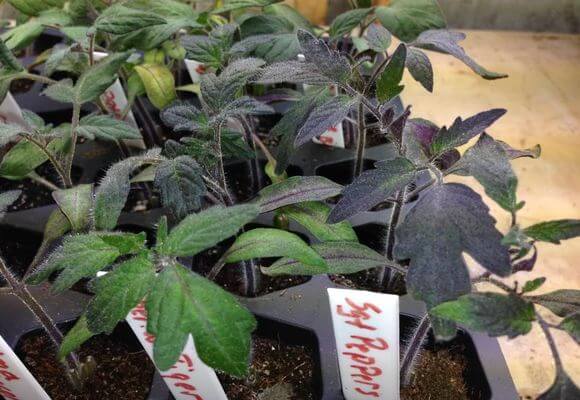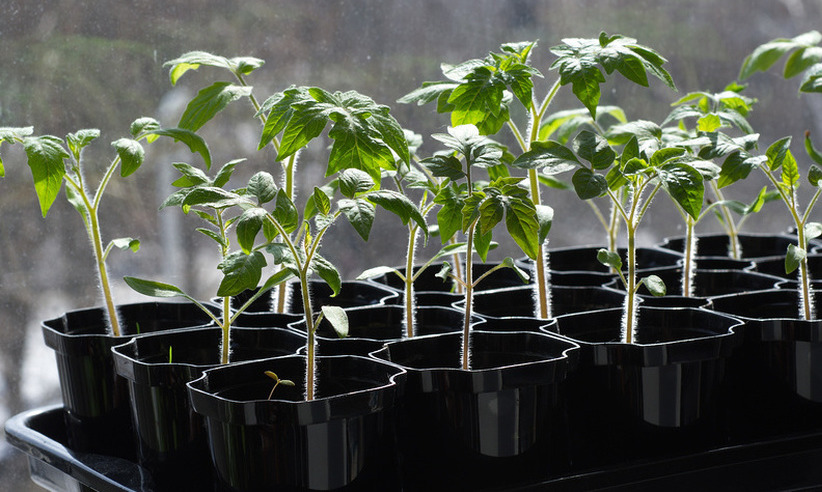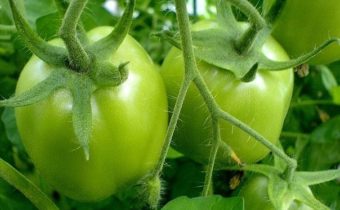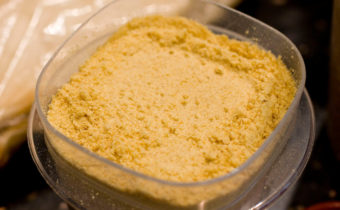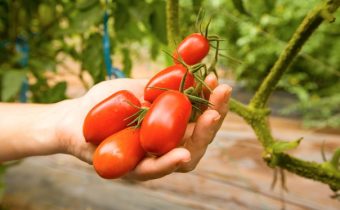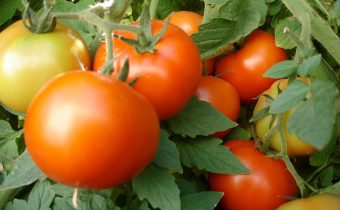What to do if tomato seedlings fall?

If a tomato seedling falls and fades at the root - it upsets the plant grower. The most common problem with seedlings lies in improper care and inappropriate conditions for young plants.
But, tomatoes can start to wither and because of undue attention or illness. In order for the seedlings to be healthy, it is necessary to comply with agrotechnical norms and to notice harbingers of problems in a timely manner.
The reasons
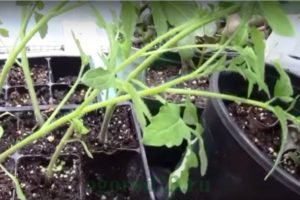 Growing tomatoes using the seedling method is not a difficult task, which even inexperienced vegetable growers can do. Sowing is done in a certain period - when the temperature and the amount of light are already sufficient for the normal development of tomatoes (end of February, the first days of March). Seedlings also need timely watering, but care must be taken to ensure that the soil is not too wet. Growing tomato seedlings is not difficult, for this it is necessary to observe the following conditions and prepare such materials:
Growing tomatoes using the seedling method is not a difficult task, which even inexperienced vegetable growers can do. Sowing is done in a certain period - when the temperature and the amount of light are already sufficient for the normal development of tomatoes (end of February, the first days of March). Seedlings also need timely watering, but care must be taken to ensure that the soil is not too wet. Growing tomato seedlings is not difficult, for this it is necessary to observe the following conditions and prepare such materials:
- suitable surface - table, windowsill;
- soil mixture;
- seed material;
- seedling containers.
But, when tomato seedlings begin to fade and fall, this indicates that some of the key conditions of care were not met or the plants became sick. There are a number of reasons that lead to such consequences - to determine the factor that provoked the deterioration of young tomato is not difficult.
Unsuitable ground
Cultivated tomatoes from seeds begin to fall, and it is not good to grow and wither most often due to the wrong soil mix. Sour and dense soil leads to yellowing, falling and wilting of seedlings at the root. In addition to an unsuitable earth mixture, the reason may be that the soil contains pathogens or pests. This happens when the soil has not been pre-disinfected. There are several methods of disinfection - spilling the ground with a slightly pink solution of potassium permanganate or hot (90 ° C) water, roasting the soil or freezing. These manipulations must be carried out even in the case of the purchase of soil mixture.
Landing density
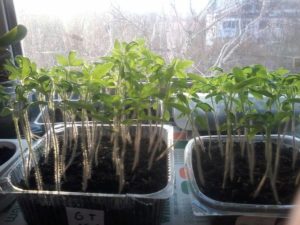 The reason following on frequency of occurrence after incorrectly picked up or not disinfected soil. The thickening of the planting leads young plants to death, as the tomatoes are closely and their root systems are unable to grow normally. To avoid such a problem, you need to follow the distance between seedlings. The distance between rows must be 5 cm, and between individual copies in the row should be about 2 cm.
The reason following on frequency of occurrence after incorrectly picked up or not disinfected soil. The thickening of the planting leads young plants to death, as the tomatoes are closely and their root systems are unable to grow normally. To avoid such a problem, you need to follow the distance between seedlings. The distance between rows must be 5 cm, and between individual copies in the row should be about 2 cm.
If the thickening of the planting has already occurred, the seedlings need a pick, otherwise the tomatoes will die. At the end of the picking, free aisles must be sprinkled with wood ash or sand - as part of the prevention of the black leg. After picking, young tomatoes for some time remain sluggish. This condition is the norm, when the lethargy of young tomatoes lasts no more than 2-3 days.
Why tomato seedlings become lilac?
Even experienced gardeners face problems in growing tomato seedlings. And one of them is the change of color ...
Tomatoes fall and wither after picking
Incorrectly executed picking - a common cause of the fall and tomatoes leads to a deterioration of the trunk and leaves, which fade and fall. To prevent such consequences, follow each of the picking rules. The main points of manipulation that will not allow damage to seedlings and prevent possible damage to the root system and stem are as follows:
- Seedlings dive after the appearance of the first 3 true leaf plates.
- To form a strong root, you need to pinch the central most elongated root to a third of the length.
- During transplantation, the hole must be deep and wide - so that the roots do not wrap.
- The composition of the soil must be correct - poorly airborne acidic soils for tomatoes are not suitable.
For growing tomatoes by seedling it is better to use not common containers, but individual peat tablets, cubes or pots. This capacity is not necessary to remove and the grown seedling is planted in a permanent place with it.
If the tomato root system was seriously damaged during the pick, the sluggish and fallen seedling will die - it is impossible to save the plant with such injuries. To prevent death during picking and transplanting, the seedling is removed from the transplant container together with the earthy clod, and several hours before the manipulation, rows of young tomatoes are plentifully poured.
Wrong watering mode
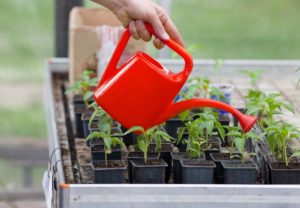 When the cotyledon leaves wither and fall off, this indicates the overflow. After picking, the need for moisture in young tomatoes decreases - it is not necessary to water the seedlings for 2-3 days. Dive, in order to prevent excess moisture, is recommended in transparent containers with a drainage hole at the bottom and in the walls. This will not only allow you to control the moisture level of the soil mixture, but also improve the degree of saturation of the earth with oxygen, since the plastic is airtight. Tomatoes are moisture-loving plants, but it is important not to overfill, as watering leads to the following consequences:
When the cotyledon leaves wither and fall off, this indicates the overflow. After picking, the need for moisture in young tomatoes decreases - it is not necessary to water the seedlings for 2-3 days. Dive, in order to prevent excess moisture, is recommended in transparent containers with a drainage hole at the bottom and in the walls. This will not only allow you to control the moisture level of the soil mixture, but also improve the degree of saturation of the earth with oxygen, since the plastic is airtight. Tomatoes are moisture-loving plants, but it is important not to overfill, as watering leads to the following consequences:
- the root system begins to rot;
- stem and leaf blades fade;
- seedling stops growth and development;
- foliage curls and turns yellow;
- there is a moldy smell.
According to the results, the seedlings fall and die. It is possible to save the plants after the overflow, but measures should be taken at the stage of hanging leaves. It is necessary to turn the container with seedlings and check the drainage hole - its presence, as well as the fact that it is not blocked. After cleaning the drainage, excess fluid will flow into the pan, and the young plants will recover.
Tomatoes is one of the crops that loves warmth and is very afraid of frost. To avoid a situation where you ...
The lack of watering also leads to the death of tomato seedlings. When the soil mixture is dry and loose in the container with young plants, the tomatoes fall and wither at the root due to lack of water. Watering tomato seedlings must be regular, moderately abundant. Each subsequent soil moistening is performed exclusively after the upper ground layer dries out. It is necessary to produce “dry irrigation” - daily soil loosening before irrigation, so that the earth is filled with oxygen and the root system of young plants can be saturated with it.
If the soil is dry, immediately pour the plants is prohibited. During the day, let's watering in the amount of 1 tbsp. on 1 plant. In another embodiment, the seedlings will wither due to excess moisture.
Illumination
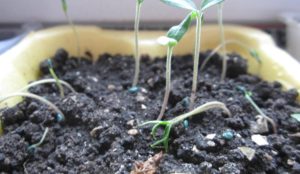 Tomato seedlings can fall due to lack of lighting. Symptoms of an insufficiently intense light source are also extended and thinned stems and leaf plates. Tomatoes need a 12-hour light day and, so that the seedlings do not wilt, it is necessary to illuminate the fitolamps.But an excess of light also negatively affects young plants - the foliage begins to "burn", turn yellow, the stems wither and lie down - the tomatoes die. During the night hours, there is no need for additional illumination, since darkness is necessary for the seedlings - in the dark time plants absorb nutrients obtained during the day from the ground.
Tomato seedlings can fall due to lack of lighting. Symptoms of an insufficiently intense light source are also extended and thinned stems and leaf plates. Tomatoes need a 12-hour light day and, so that the seedlings do not wilt, it is necessary to illuminate the fitolamps.But an excess of light also negatively affects young plants - the foliage begins to "burn", turn yellow, the stems wither and lie down - the tomatoes die. During the night hours, there is no need for additional illumination, since darkness is necessary for the seedlings - in the dark time plants absorb nutrients obtained during the day from the ground.
Temperature disturbances
Failure to comply with the temperature regime is the fifth most frequent reason for causing tomato seedlings to fall and fade at the root. When the temperature in the room exceeds 36 ̊C, the young plant dries out and perishes from overheating. Because of this, it is forbidden to place a seedling container near the heaters. The optimum temperature for young tomatoes is 18-20 C.
After the plants get stronger, the seedlings need to be hardened - at night the temperature is gradually lowered to 3-4 ° C. This will strengthen the plants - they, when planted in open ground, will not be able to tolerate favorable environmental conditions. But drafts are unacceptable, as the whiffs of cold air will lead to fading. At the time of ventilation of the premises it is necessary to clean the seedlings away from open windows.
When growing on a window sill in a house or apartment, it is necessary to ensure that the plants are protected from drafts and are far away from the glass, since the glass sheet gives off cold and leads to the fact that tomato seedlings may begin to fade. Before the seedling container is placed on the window sill, it is necessary to check whether it blows out of the window and close all the identified gaps. Opening the vent for airing is also prohibited, as the cold air will destroy the young immature plants. They do not recommend placing seedlings on window sills of windows facing north - tomatoes will experience a lack of sunlight, which will be expressed by the following symptoms:
- stunting or overlong stems;
- seedlings will become lethargic;
- due to lack of sunlight, the stems will fall.
It is impossible to put seedlings on the southern sill, as young tomatoes will get burns. It is better to place the plants on the east, in extreme cases - the west, window sills.
Fertilization violations
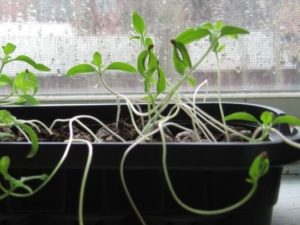 Often problems with tomato seedlings occur due to irregularities in the issue of feeding - tomatoes lack the substances for full development. But before trying to adjust the feed for the alleged violations, you need to carefully examine the plants - depending on the shortcomings of fertilizer, the manifestations and solution of the problem differ:
Often problems with tomato seedlings occur due to irregularities in the issue of feeding - tomatoes lack the substances for full development. But before trying to adjust the feed for the alleged violations, you need to carefully examine the plants - depending on the shortcomings of fertilizer, the manifestations and solution of the problem differ:
- The leaves turn yellow, and a light stripe appears on the edge or blackening begins from the edge with gradual drying. Such changes indicate a lack of potassium in the feed, and potassium phosphate or wood ash is added as a fertilizer.
- Tomatoes are small and yellow in color, with streaks. This indicates a lack of the nitrogen component in the top-dressing, to eliminate liquid nitrogen fertilizers are being applied or the plant is transplanted into a larger vessel.
- The color of the leaves changes to blue-violet, reddish or purple. Such changes occur due to lack of phosphorus. To solve the problem supplement the diet with potassium monophosphate.
- If the foliage turns yellow to white, and the veins remain green, the tomatoes pick up iron. To replenish this element, the soil is refreshed and watering with 1% solution of iron sulphate is added as a feed.
Fertilizers for plants should be made according to the instructions - exceeding the concentration reduces the effectiveness and leads to burns of the root system. In such cases, the sprout dies due to the death of the roots. The primary sign of overestimation of dosage is the formation of white bloom on the top layer of the earth. This plaque also leads to poor air circulation. To eliminate it, apply solutions of humic salts - sodium gutamate or potassium gutamate.3 grams of active ingredient is enough for 10 liters of water.
Salts of humic acids are natural fertilizer. The use of Gutamah achieve increased yields.
Diseases from which tomato seedlings suffer
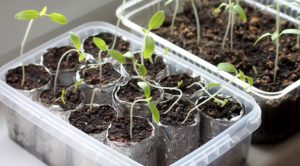 If the standards for the care of tomatoes were fully met, seedlings can also wither. This is due to the possibility of the development of various diseases on tomatoes. They occur when the soil is not disinfected or when adjacent pots with vegetation are damaged. Treatment for diseases is determined by the degree of damage to tomatoes. The most common fungal and bacterial lesions:
If the standards for the care of tomatoes were fully met, seedlings can also wither. This is due to the possibility of the development of various diseases on tomatoes. They occur when the soil is not disinfected or when adjacent pots with vegetation are damaged. Treatment for diseases is determined by the degree of damage to tomatoes. The most common fungal and bacterial lesions:
- Fusarium;
- rot;
- blackleg.
Each of the diseases is determined by the characteristic symptoms. These violations are expressed by the withering of the plant - yellowing of the leaves and gradual dying off of the trunk. If the situation is not running, part of the tomato can still be saved. But, if the disease has significantly damaged the tomatoes - most will have to be destroyed, in order to save other vegetation.
Fusarium
When gardening seedlings turn yellow gradually - from the lower leaves to the upper ones, this is a clear sign of Fusarium. Such a fungal disease can affect most plant crops. If fusarium caused the wilting of the tomato seedlings, the plants can be saved until the yellowing reaches the top leaves. To do this, the seedlings are transplanted into a container with disinfected land, and when the greenness is completely yellowed, they are thrown away. To avoid the disease you need to choose the types of tomatoes that are resistant to Fusarium.
Blackleg
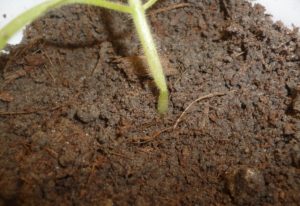 Blackleg - A common bacterial lesion, which is detected on most crops. If the problem was found on any germ - take urgent measures, as the bacteria are quickly transferred to the nearest vegetation. To identify the disease you need to pay attention to the condition of young tomatoes:
Blackleg - A common bacterial lesion, which is detected on most crops. If the problem was found on any germ - take urgent measures, as the bacteria are quickly transferred to the nearest vegetation. To identify the disease you need to pay attention to the condition of young tomatoes:
- lethargy of the trunk and leaves;
- rotting root collar at the base;
- yellowing plants.
To get rid of the black leg all the affected tomato must be thrown away. The rest of the seedlings are washed in a weak solution of manganese and transplanted into fresh soil. The earth from the former vessel is heated at high temperatures and treated with manganese. Before using the pot for seedlings after bacterial contamination, it is treated with boiling water and washed with a disinfectant solution.
To save partially damaged plants will not work - they also need to be thrown away so as not to spread the infection in a new vessel.
Tomato rot
With abundant watering and lack of heat, rot can develop. The leaves of plants affected by this disease turn yellow, and the legs gradually wither and rot. It is not possible to save tomato seedlings with rot - all sprouts should be carefully examined and transplanted into fresh ground only whole specimens. Rotting tomatoes are thrown away, and the ground is treated with heat.
Preventive care
Take steps to save tomato seedlings better before the primary symptoms. The main rule - the seeds are bought only in verified places, after determining the expiration dates. This is due to the fact that most of the diseases occur due to the weakness of the seeds. So that young plants do not sluggish and fall, it is necessary to observe the standards of care and to take preventive measures:
- Soil before planting treated with manganese solution or calcined.
- Seeds are treated with fungicides or pink manganese solution.
- Illumination near tomatoes provide for 12 hours daily.
- Seedlings need warm and dry fresh air.
Before planting, it is imperative to check the acidity of the soil or to use the purchased soil neutral composition. If you are feeding, then phosphate compounds are optimal for tomatoes.They are also careful with watering - they pour a lot of water, but the soil should not be like dirt. If there are risks of diseases, measures should be taken immediately - add vermiculite to the soil or spray tomatoes with special solutions.

